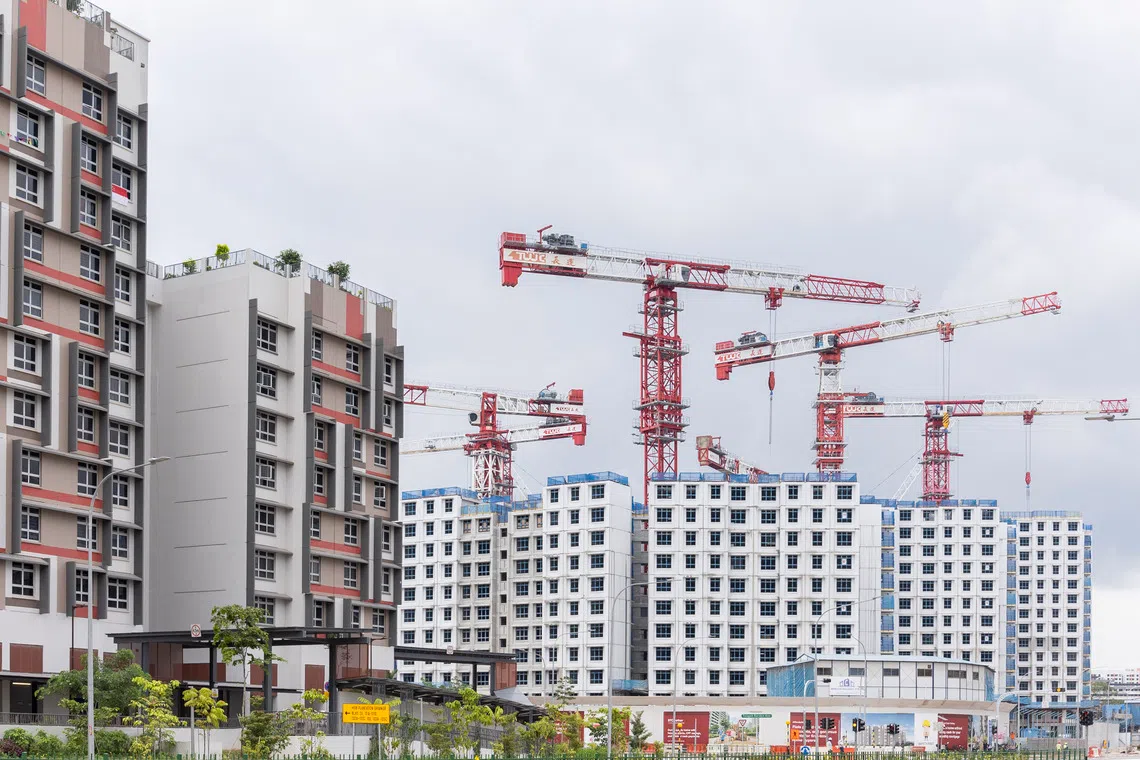BTO income ceiling can be raised, singles eligibility age lowered, when ‘right conditions’ in place
Sign up now: Get ST's newsletters delivered to your inbox

The current BTO income ceiling, which was last revised in 2019, is $14,000 for couples and families.
ST PHOTO: BRIAN TEO
Follow topic:
- Income ceiling reviews for BTO flats are planned to align with economic trends, ensuring more Singaporeans are eligible for HDB flats.
- Singles may have earlier access to BTO flats (currently 35+) when BTO flat supply increases, addressing unmet demand.
- The government will launch 55,000 units from 2025-2027.
AI generated
SINGAPORE – The income ceiling for Build-To-Order (BTO) flat buyers can be raised when the “right conditions are in place”, said Senior Minister of State for National Development Sun Xueling.
The eligibility age for singles to buy BTO flats – now 35 – can also be lowered when there is a larger supply of flats, she told Parliament on Sept 26.
“As we build more, build faster and build better, there will be greater capacity to meet the aspirations of more Singaporeans,” Ms Sun said, adding that the Government will review the income ceiling.
The purpose of the review is to keep pace with economic trends and ensure that the majority of Singaporean households remain eligible for HDB flats, she said on the fifth and final day of the debate on the President’s Address.
In her speech, Ms Sun also touched on the Government’s efforts to better plan new estates, as well as on how older estates will be rejuvenated.
The current BTO income ceiling, which was last revised in 2019, is $14,000 for couples and families.
Ms Sun noted that there may be young Singaporeans doing well at work and earning more, and are hence afraid they will exceed the HDB income ceiling and not be eligible for a BTO flat.
“We recognise that incomes have gone up over the years,” she said, adding that the Government will therefore review the income ceiling.
Ms Sun also addressed the housing aspirations of singles, who can apply for a BTO flat only after reaching the age of 35.
She said the Government has moved to improve singles’ access to flats in recent years, such as by expanding access to two-room flexi BTO flats islandwide, increasing housing grants for singles and giving singles priority when they apply to live with or near their parents.
“We understand there is still unmet demand from some singles who wish to apply for a BTO flat before reaching the age of 35,” said Ms Sun.
“To make further policy moves, we need policy space and a higher supply of BTO flats.”
To this end, Ms Sun said that HDB will “continue to build more, build faster and build better” in this term of government.
She noted that the Government has exceeded its commitment of launching 100,000 new flats between 2021 and 2025, and will launch 55,000 flats from 2025 to 2027
At least 4,500 flats with shorter waiting times will be launched in 2025, said Ms Sun, with about 4,000 of such flats to be launched annually in 2026 and 2027 – a more than 20 per cent increase compared with earlier plans.
Such flats have wait times of under three years, and about 3,100 will be launched in October.
Ms Sun’s comments come on the back of recent increases in flat supply in two upcoming estates – Mount Pleasant and the former Keppel Club.
Both will have 1,000 more flats than initially projected, with Mount Pleasant to now have about 6,000 flats, in an estate named Berlayar
Ms Sun also said that a steady private housing supply will be sustained, with more than 25,000 private units slated for launch from 2025 to 2027.
Affordability
The Government will continue to price BTO flats so that they are affordable for buyers with different income levels.
Ms Sun said standard flats will form a significant proportion of annual supply, to provide sufficient options for buyers with tighter budgets.
BTO flats across flat types will also be priced well below comparable resale flats, she said.
She pointed to the most recent BTO sales exercise
Using examples from the July 2025 BTO exercise, Ms Sun said a couple earning a combined $10,000 a month would have been able to purchase a standard four-room flat and have a 25-year loan from the HDB serviced fully by Central Provident Fund contributions.
For a prime four-room flat, this couple would have paid up to $350 in cash a month – in addition to CPF contributions – to service their loan.
As for a couple with a combined income of $6,000, Ms Sun said they would have been able to afford any three-room flat on offer at the July exercise using only their CPF contributions to service a housing loan.
“In fact, because of the additional grants they receive, this couple would also be able to afford the average standard four-room flat in this exercise without any cash outlay,” she said.
As for resale flats, Ms Sun said there are options available at lower prices in many locations.
For four-room flats with at least 70 years remaining on their leases, Ms Sun said there are flats going for less than $700,000 in Tampines and Punggol, less than $600,000 in Sembawang and Yishun, and less than $550,000 in Jurong West and Woodlands.
She said that first-time buyers pay even less if they qualify for grants, which can amount to $230,000.
Ms Sun noted that the resale market is cyclical – resale prices fell for six consecutive years before the Covid-19 pandemic, then rose – and that there now is a moderation in resale price growth.
She said that resale prices will also be moderated as more flats are reaching their minimum occupation period in the coming years, which makes them eligible for resale.
Planning new estates
On planning for new estates, Ms Sun said the Government has heard feedback from Tengah residents that amenities such as cooked food options and childcare centres were not available when they first moved in.
She said that the inter-agency BTO Coordination Committee
To prepare for coming large-scale BTO projects, said Ms Sun, the committee is looking into a variety of issues such as transport accessibility, construction disamenities such as noise and dust, and mobile signal strength.
She highlighted efforts in three areas – linkways, childcare and food options.
In new estates, the Government will see how residents can be connected to more bus stops and shop clusters via sheltered linkways from the onset, she said.
“This can potentially be implemented at the BTO construction stage, especially if there are cost savings.”
As for childcare, she said the Government intends to build childcare centres earlier in the development of new estates so they can be handed over to operators faster, and in a smoother manner.
She noted that it is crucial to minimise the gap between the estate’s first residents moving in, and the commencement of childcare services.
On food, Ms Sun said operators are hesitant to open their shops or stalls when footfall may be low in the initial period when residents first move into a new area.
She said the Government already provides a rent-free period to help operators tide over this period, and added that the committee is studying how to improve such measures, as well as alternatives for residents.
Estate rejuvenation
The Government is focused not just on new homes, but equally on rejuvenating mature, decades-old towns, said Ms Sun.
She cited the second round of the Home Improvement Programme, or HIP II, which will be implemented for flats aged 60 and older.
“Works will be more comprehensive, using updated technology,” she said, giving the example of using scanning technology to trace the root cause of water seepage.
Beyond individual flats, she said, the Government will also continue to refresh whole estates through programmes such as Remaking Our Heartland and the Neighbourhood Renewal Programme.
Ms Sun said that over six decades, Singapore has “moved from the urgent task of housing a young nation, to a nation of home owners proud of our quality homes, well-designed towns, and strong communities”.
“We will carry this spirit and legacy, meet the needs of today and fulfil our aspirations for the future,” she said.


